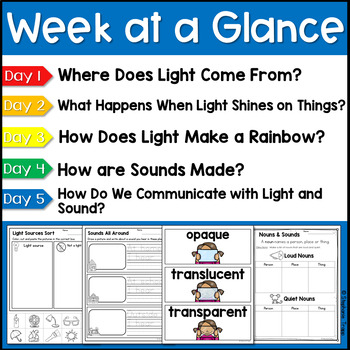Light and Sound Unit for Kindergarten and First Grade
- PDF
What educators are saying
Description
Where does light come from? How are sounds made? Find the answers to these questions and more during this NGSS-aligned light and sound unit! The week-long unit includes detailed daily lesson plans with literature suggestions. It incorporates science, reading, writing, math and handwriting. It also includes experiments and links to videos that complement the unit study.
Watch the VIDEO PREVIEW to learn more, or click on the PREVIEW to read each lesson plan, see the Week-at-a-Glance planning sheet, as well as examples of printables and activities.
Teacher Features You’ll Love:
• Detailed daily lesson plans
• Week-at-a-glance planning guide
• Key concepts and objectives
• Extensive literature lists
• Video links and QR codes
• Activity directions and printable templates
What’s Covered in the Unit?
Day 1: Where Does Light Come From?
• Drawing in the dark activity
• All About Light book
• Light sources sort
Day 2: What Happens When Light Shines on Things?
• Experimenting with light
• All About Light book
• Transparent, Translucent, Opaque scavenger hunt
Day 3: How Does Light Make a Rainbow?
• Rainbow on the Wall activity
• Roy G. Biv emergent reader
• All About Light book
Day 4: How are Sounds Made?
• Sound guessing game
• Seeing sound waves activity
• Sounds all around activity
Day 5: How Do We Use Light and Sound to Communicate
• Clap Once for Yes game
• Communicating with light and sound sort
• Color by sound challenge
Math Connections:
• Ordering numbers least to greatest
• Counting within 100
• Place value: tens and ones
• Addition and subtraction
• Ten frames
• Comparing numbers with >, <, =
• Graphing
• Time to the hour
• Measuring with nonstandard units
• Word problems
Literacy Connections:
• Light and sound word wall
• Beginning letter sounds /l/ and /s/
• Beginning consonant sounds
• Read and draw words that end with -nd
• Read and write words that end with -ight
• Words that rhyme with sound
• Sound out CVC words
• Compound words
• Antonyms
• Onomatopoeia (sound words)
• Nouns
• Pre-primer sight word story
• A Bright Idea writing activity
• Favorite color writing activity
• Character spotlight writing activity (use with any book)
• Rainbow Recipe writing activity
• Too Loud! writing activity
• Quiet Mouse writing activity
• Communicating with Light and Sound writing activity
Questions? Feel free to email me at primarythemepark@gmail.com.
Find more cross-curricular units for K-1 HERE!
Thanks so much for stopping by!





